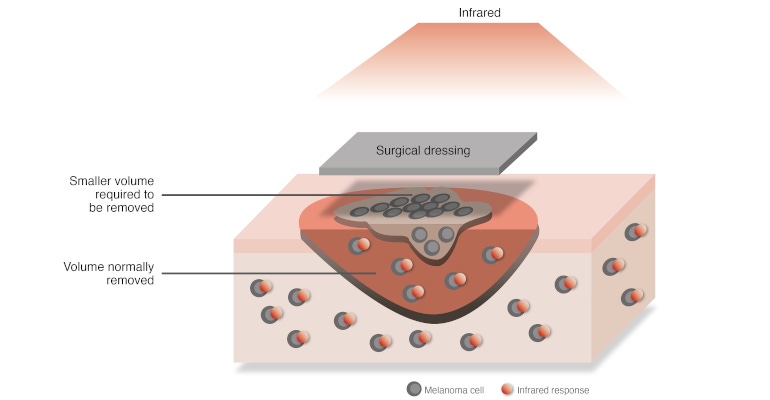Surgical Dressing Kills Cancer Cells, Speeds Wound Healing
When heated briefly using near infrared light, a new hybrid graphene/elastin dressing prevents the recurrence of skin melanoma and heals wound tissue.
September 12, 2022

Scientists at the University of Nottingham have created a new type of surgical dressing that, when heated, prevents the regrowth of skin melanoma cancer cells while also promoting regrowth of healthy wound tissue.
Normally, melanoma is treated by surgical resection, which is surgically removing tissue, said Yuanhao Wu, the study's lead author, in an interview with Design News. Wu is now associate professor of plastic and reconstructive surgery at Wuhan Union hospital, attached to Huazhong University of Science and Technology.
But because melanoma is very aggressive, tumor cells may become resistant to treatment. This can lead to post-surgical recurrence, requiring more surgery often combined with radiation and chemotherapy, Alvaro Mata, professor of biomaterials and biomedical engineering at the University of Nottingham, told Design News.
"The resection must [therefore] remove a volume of tissue significantly bigger than the size of the tumor to minimize possible recurrence," he said.
The research team published the results of their study in an article in Advanced Functional Materials.
Hybrid Material Has Dual Functions
Photothermal therapy (PTT) converts light into heat with conductive materials such as graphene oxide and uses that heat to kill cancer cells.
Other PTT treatments tend to use graphene oxide in the form of particles. These must be injected to get inside or close to the tumor, which can be complicated in terms of both achieving precise delivery, and regulatory aspects, said Alvaro.
"The dressing we created is formed by the self-assembly of elastin with graphene oxide into multiple layers, similar to how bricks and mortar are integrated," he said. "That design enables us to turn the particles into a macroscopic dressing you can manipulate and apply."
Alvaro said that two key material design features make this new treatment possible. The first is the hybrid material that incorporates both conductive graphene oxide and elastin, a biological material to promote healthy cell growth. The second key feature is a reduction process that makes the graphene oxide conductive within the hybrid material.
More Conductivity, Produced More Efficiently
The new process uses near infrared light (NIR) to heat the hybrid material. But making graphene oxide conductive enough has previously required harsh processes and high temperatures up to 180° C that would harm the material's biological component. So University of Nottingham researchers devised a method that increases conductivity more efficiently, requiring lower temperatures of 80° C.
"Because of this conductivity, the dressing can be heated by a short exposure to near infrared light in a controlled manner, killing any remaining cancer cells and preventing recurrence," said Alvaro.
Since the hybrid material is friendly to cell growth, the dressing also enhances the regeneration of healthy tissue to accelerate healing, especially the migration of endothelial cells that are critical for regeneration.
"Its use may therefore also reduce the area needed for resection," he said. "As far as we know, there are no other dressings that have this dual function to prevent the recurrence of melanoma and promote healing."
Possible Future Uses for Dressing
Because of the dressing's design, only very short exposures to NIR light are needed, said Wu. For mice, that's 15 seconds every 48 hours. "So in the future we can imagine that a patient could apply this dressing at home, since it is very simple and practical to do," she said.
Other kinds of skin cancers, such as squamous cell carcinoma, could potentially be treated using this dressing. That's because all types of skin cancers are tumor cells, which can in principle be killed with a similar heat treatment.
Also, with minor modifications to the dressing, it might be possible to use it to treat other types of skin wounds, such as those caused by diabetes or associated with it, she said.
About the Author(s)
You May Also Like

.jpg?width=300&auto=webp&quality=80&disable=upscale)

